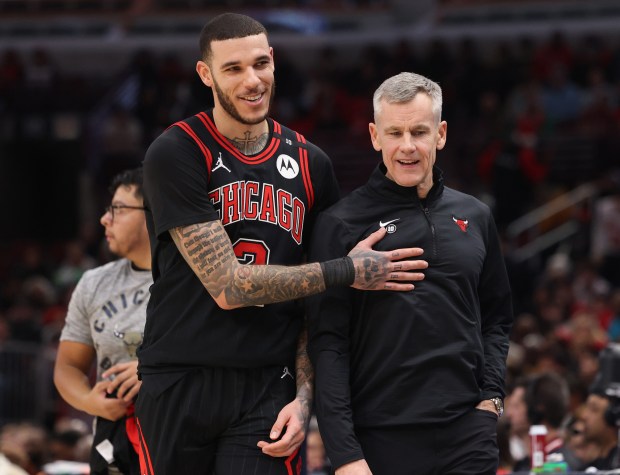The Chicago Bulls have almost accomplished the impossible with Lonzo Ball this season.
Getting him back on the court was enough of an achievement. Ball has excelled far beyond that milestone, regaining the confidence and creativity that once put him among the top point guards in the NBA.
Less than two weeks before the Feb. 6 trade deadline, the Bulls now have a new stage of the process to consider: Could Ball actually be their best trade asset?
Looking at his on-court performance alone, pitching Ball to other teams shouldn’t be a difficult task for executive vice president of basketball operations Artūras Karnišovas. Before his knee injury, Ball was one of the league’s most-sought point guards — and he rapidly returned to form after a 2½-year layoff.
Everything about Ball’s performance this season, though, comes with a caveat: The sample size is small. He has played in only 24 of the Bulls’ 45 games, averaging 20.5 minutes. But even in that limited time, it’s clear Ball still is equipped to be a game changer. His 3.7 assists and 1.6 steals per game translate to 6.5 assists and 2.8 steals per 36 minutes.
For Ball’s recovery to be considered complete, he needs to be cleared of the 25-minute restriction by the Bulls medical staff that’s currently in effect through the Feb. 14-18 All-Star break. But at the same time, that limitation could make Ball an adaptable option for teams looking for one final piece in a playoff push.
He wouldn’t — and couldn’t — demand starter’s minutes. He wouldn’t disrupt a team’s style of play. Instead, Ball can plug into any system to provide 25 minutes of razor-sharp defense and effortlessly creative playmaking. Nearly every contender — from the Boston Celtics to the Denver Nuggets to the Houston Rockets — could utilize that kind of addition to boost its postseason run.
OK, so what’s the catch?
The hangup is obvious. No front office would dispute Ball’s talent. There has been widespread excitement across the league about how quickly he has returned to his prior form. But the pattern of injuries spanning his entire NBA career dampens any enthusiasm.
Ball, 27, isn’t just fighting against the unlikeliness of his knee recovery. It’s hard to shake the “injury-prone” label in this league. He never has played 65 games in a season. Even this season, he was sidelined for four weeks by a wrist sprain — although he felt that layoff ultimately helped him build more strength in his knee to endure the full length of this season.
Whether fair or not, it might be difficult to convince other teams that 24 games is ample evidence Ball is ready to shoulder the physical challenge of the postseason.
And it’s not as if teams have to wait forever for Ball to hit the open market again. He’s in the last season of his four-year, $80 million deal. For many teams, it might be worth it to let Ball play out the rest of the season in Chicago and prove he’s durable enough to last an entire season before pursuing him in free agency.
Still, it’s hard to believe one team wouldn’t be willing to take that risk as it weighs its options for the playoffs — especially in the Western Conference, in which teams are jockeying just for a chance at the play-in tournament.
There’s another catch: The Bulls might not be ready to part with Ball.
The hesitation is mutual. Ball has undergone the entirety of his exhaustive recovery process with the Bulls. The team committed fully to a process that included three surgeries, the last of which was an unprecedented cartilage transplant that no NBA player had successfully returned from.
For Ball, the risk of upending the final stages of that recovery — even if it meant finishing the season on a more competitive roster — might outweigh the potential reward of pushing for a trade.
On the other end of the bargaining table, the Bulls aren’t eager to move on from Ball. He’s playing excellent basketball. He quietly commands the locker room, bringing a layer of veteran leadership to a team desperately seeking direction amid a transition season. And while he may choose to walk in free agency, the Bulls already made a long-term investment in his recovery.
The next two weeks will be a test for the Bulls, who are trying to shop stars Zach LaVine and Nikola Vučević in addition to role players such as Patrick Williams. The complications involved in trading Ball might force them to hold off on a decision until after the season.
But each of the final seven games before the deadline is an opportunity for Ball to prove he’s ready to compete for something bigger.



